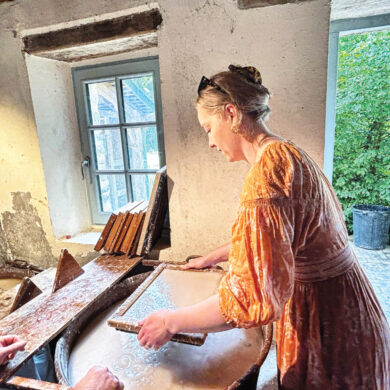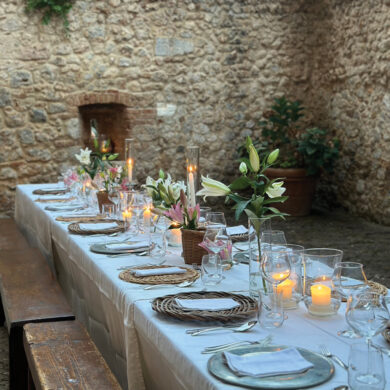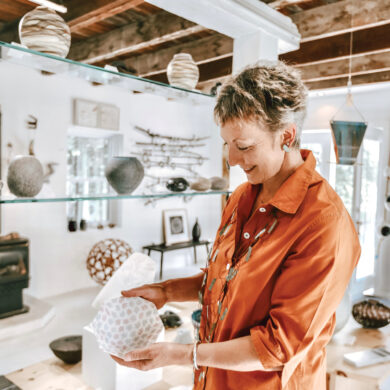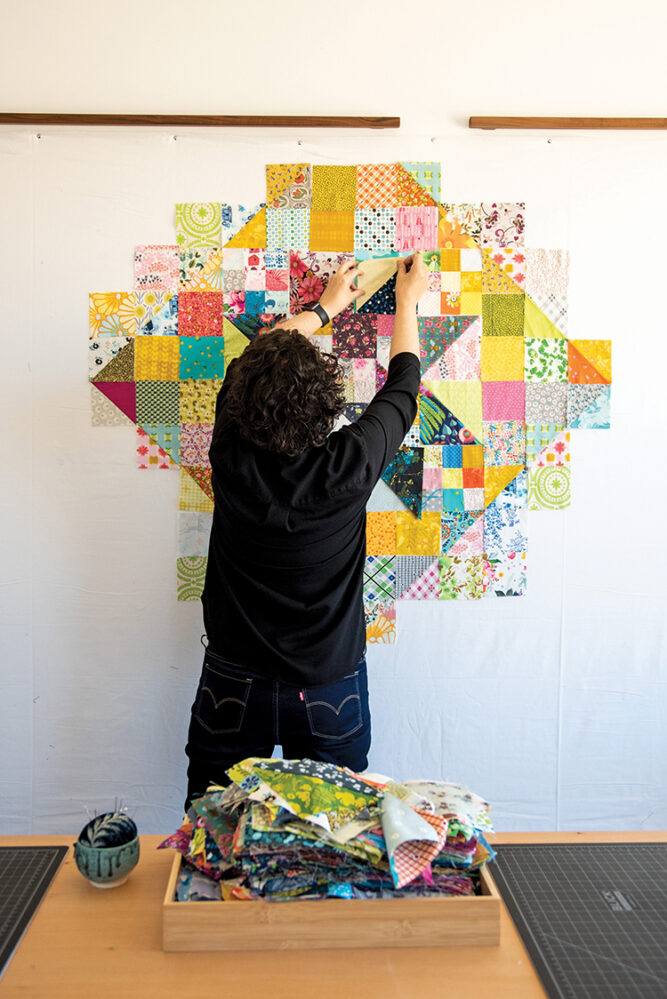
The word “patchwork” has many meanings for me — both literally and figuratively. I have patched together a beautiful life but it hasn’t been without its challenges. Much like the problems I can experience when making a quilt, there are tension issues, points that don’t quite line up, colors that clash. The process of designing and making quilts and patchwork has given me some valuable insight into how I look at life and what I want out of it. Working through the steps of making a quilt is learning patience, slowing down and trusting the process to get me to the desired outcome.
As a middle schooler in my home state of North Carolina, recurring bouts of strep throat left me in bed and bored for several weeks one winter. Not sure why I initially asked for it, but I requested a copy of the current issue of Vogue. I had lots of idle time to look through the pages over and over again. It opened my mind up to the power of style — beautiful fabrics, color combinations and shapes.
I went on to study apparel design in college, and my plan was to move to New York City after graduation to pursue a career in fashion. I managed to stay on that trajectory until I was offered a post-graduation job as a spec sheet writer for a very popular brand of clothing. The home office was half an hour from my hometown. My plans to move were canceled and I began my career in the apparel industry.
Our company was highly successful, and I was promoted to womenswear and then the menswear division (the largest). My job encompassed all the aspects of apparel design I was most interested in: sourcing beautiful fabric, studying trends, the business aspect of fashion and gaining a true understanding of that certain something that people with style possessed. It was extremely fast-paced and so exciting for me. I continued working in the fashion industry for several years, eventually meeting my husband in the field and moving to the Pacific Northwest to pursue a design job in Seattle, Washington.
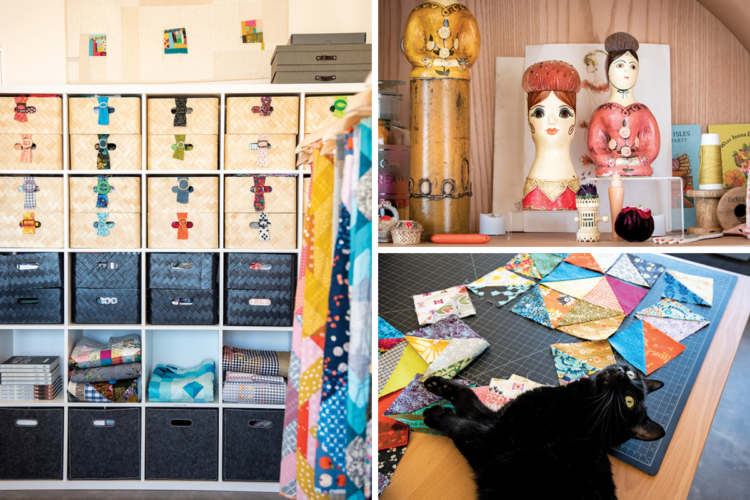
When I was expecting my first child, we decided to try to make our household finances work for me to stay home with our baby. Three years later her little brother arrived. I decided that the industry I loved so much was too fast-paced to work in with little kids at home.
But I was missing a creative outlet. I have always loved making things with pretty fabrics, and have a knack for many kinds of DIY, but never had a focused application for the projects I made — other than the creative work I did in my career and decorating our home. On a whim I started an online craft blog in 2005, all focused on those simple projects and life with my kids.
The upcycling projects I documented caught the attention of a regional chain of thrift stores. I was hired to gather items sold in their stores and create simple, approachable projects to inspire their customers. It was such a fun way to express my creativity, and something I could fit into parenting small children. Eventually, though, I grew tired of having numerous projects in various stages of completion all over the house. I craved more order and intention in what I was making.
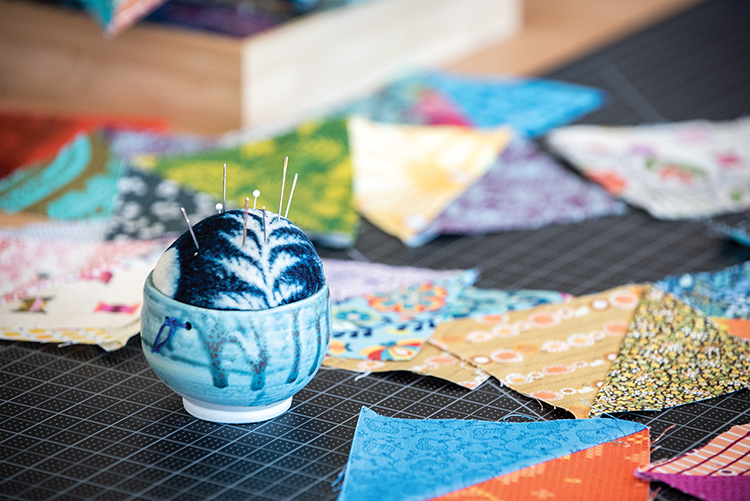
I grew up around sewers but not quilters. The idea of making a quilt appealed to me, but I knew there was plenty to learn. The apparel design industry gave me a true love for the power of fabric — the smell of a favorite blanket, the feel of the perfect pair of jeans, the way a loved garment could make you feel while wearing it. A fabric’s ability to evoke memories for us is fascinating to me — the florals of grandma’s kitchen curtains, a favorite childhood doll’s calico dress. It was time for me to really pursue my passion for quilts.
The first quilt I ever made, 24 years ago, was sewn from fabrics collected from my daughter’s baby clothes and nursery. The result would win no prizes but was made with love. Even though I had zero experience making quilts before that one, when it was finished I immediately wanted to make another one. And another one. I have been a voracious student of modern quilting ever since. There are parts of the process I enjoy more than others, but every aspect of making a quilt appeals to me in some way.
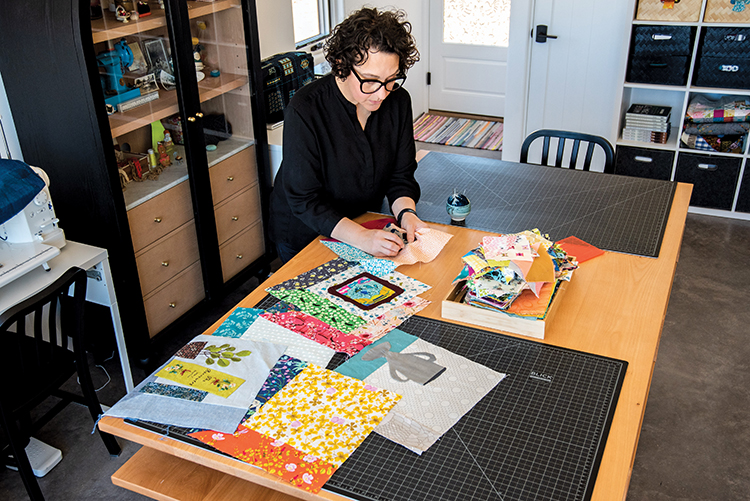
My creative passion has now become my full-time work. I have written two books, created an online membership program to foster community around quilting and teach workshops both in person and online. The physical space I create in has also evolved: Beginning on one side of our dining room table, spilling into and finally taking over a small spare bedroom, then moving into one large side of our basement.
These days I live in a quiet, remote area outside of Santa Fe, New Mexico, and the studio space I call home has been custom-built to my own specifications, just for me. I feel incredibly lucky. The whole project took just under a year to build as an addition to our home.
Knowing this would most likely be where I would spend most of my days for many years to come, I carefully designed and planned out what I wanted in it and where items would be stored. A professional organizer helped me create not only a space with a place for everything I need daily, but one that also inspires me every time I walk into it.
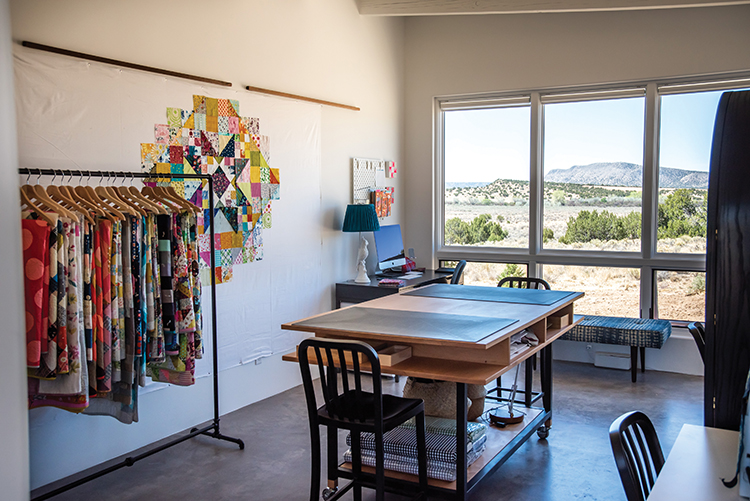
In the past, any studio surface of mine would usually become a dumping ground for piles of things to be dealt with later. In this new space, it became important to take a hard look at what I wanted out of a space being built entirely for me and my craft. What kind of work do I want to produce in my studio? How does the space honor that work?
We went through a huge downsizing process before moving to Santa Fe and it gave me a new relationship with all of my belongings. As I reduced the number of things I owned, I began to get a clear view of which items were most important to me. It has given me a better understanding of how too much clutter and disorder actually hinder my creative process. Everything in the studio has meaning and purpose in my creative process and life.
Making patchwork these days involves huge messes. As many as 50 to 75 different fabrics go into one of my quilts, and pulling all those out can create chaos in the studio. But this kind of clutter no longer causes me to feel uninspired or anxious, as it once did. When the work is completed, all the tools and fabrics are returned to their places. This reset process (what I sometimes call procrasti-cleaning) can be as enjoyable for me as the quilt designing process.
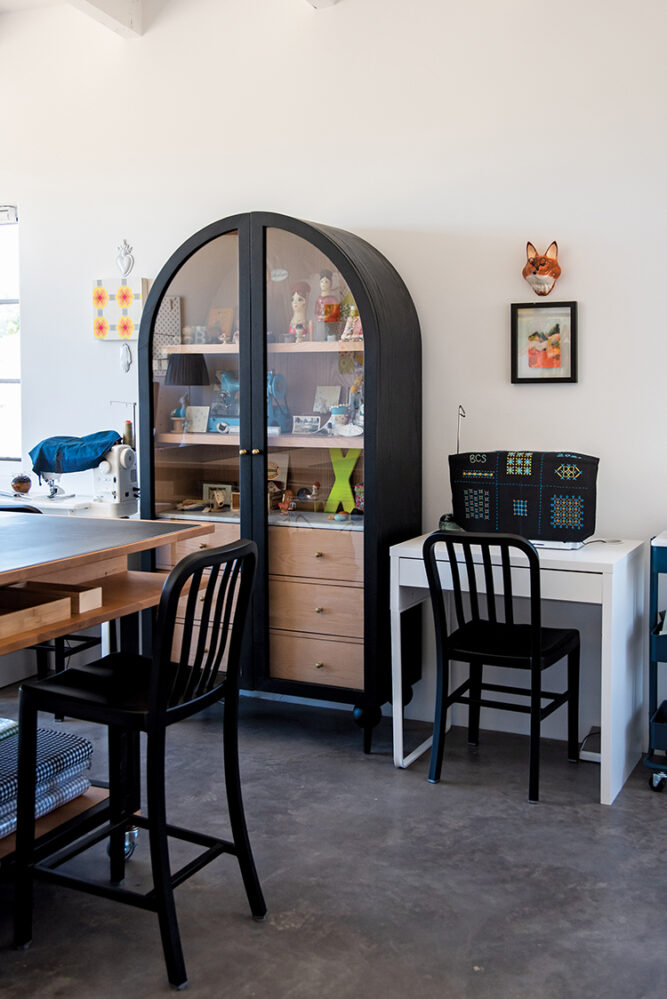
The amount of physical things I have in my studio has been pared down significantly from previous studios. However, I will never be a minimalist! My coveted collections of needlework samplers, vintage photographs and antique sewing notions found over the years all bring me lots of inspiration. These items used to be dotted around the creative space I was working in, but now I prefer to keep them in a large black studio cabinet of sewing curiosities I call Fern.
Fern keeps special items safely behind glass, away from our curious cat Toby, and protected from dust and the intense New Mexico sun that shines through the large studio windows along the west wall. I use Fern as a revolving display of things that inspire me. Grouping those things together gives them a place of honor and reduces visual clutter around the space. Changing out the contents with the seasons gives each piece a chance to shine and helps me to “see” them again.
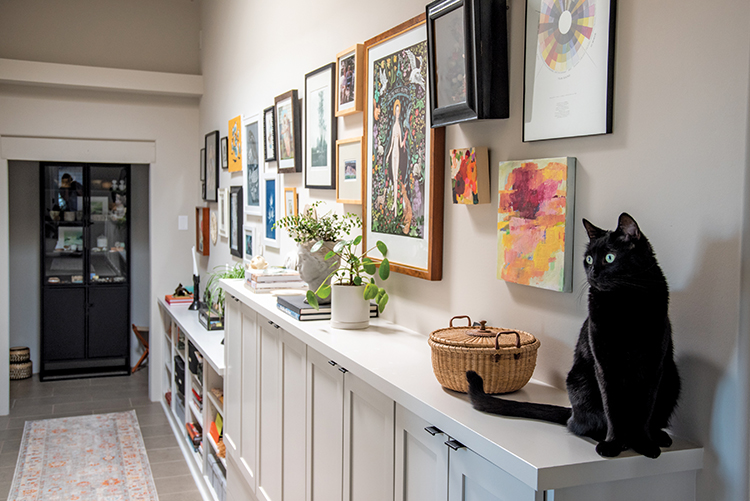
These days, I teach and connect with others over a shared love and curiosity of patchwork from my studio space. I get to do what I love, every day. I open my studio up once a year for local residents and share my work.
Living in the high desert of the Southwest has sparked even more curiosity and passion for what I do. It’s with this curiosity that I approach my quilt-making practice today.
Much like a photo album can be a collection of memories, a patchwork quilt can be a gathering of all kinds of memories and experiences through fabrics.

The word “patchwork” has many meanings for me — both literally and figuratively. I have patched together a beautiful life but it hasn’t been without its challenges. Much like the problems I can experience when making a quilt, there are tension issues, points that don’t quite line up, colors that clash. The process of designing and making quilts and patchwork has given me some valuable insight into how I look at life and what I want out of it. Working through the steps of making a quilt is learning patience, slowing down and trusting the process to get me to the desired outcome.
As a middle schooler in my home state of North Carolina, recurring bouts of strep throat left me in bed and bored for several weeks one winter. Not sure why I initially asked for it, but I requested a copy of the current issue of Vogue. I had lots of idle time to look through the pages over and over again. It opened my mind up to the power of style — beautiful fabrics, color combinations and shapes.
I went on to study apparel design in college, and my plan was to move to New York City after graduation to pursue a career in fashion. I managed to stay on that trajectory until I was offered a post-graduation job as a spec sheet writer for a very popular brand of clothing. The home office was half an hour from my hometown. My plans to move were canceled and I began my career in the apparel industry.
Our company was highly successful, and I was promoted to womenswear and then the menswear division (the largest). My job encompassed all the aspects of apparel design I was most interested in: sourcing beautiful fabric, studying trends, the business aspect of fashion and gaining a true understanding of that certain something that people with style possessed. It was extremely fast-paced and so exciting for me. I continued working in the fashion industry for several years, eventually meeting my husband in the field and moving to the Pacific Northwest to pursue a design job in Seattle, Washington.

When I was expecting my first child, we decided to try to make our household finances work for me to stay home with our baby. Three years later her little brother arrived. I decided that the industry I loved so much was too fast-paced to work in with little kids at home.
But I was missing a creative outlet. I have always loved making things with pretty fabrics, and have a knack for many kinds of DIY, but never had a focused application for the projects I made — other than the creative work I did in my career and decorating our home. On a whim I started an online craft blog in 2005, all focused on those simple projects and life with my kids.
The upcycling projects I documented caught the attention of a regional chain of thrift stores. I was hired to gather items sold in their stores and create simple, approachable projects to inspire their customers. It was such a fun way to express my creativity, and something I could fit into parenting small children. Eventually, though, I grew tired of having numerous projects in various stages of completion all over the house. I craved more order and intention in what I was making.

I grew up around sewers but not quilters. The idea of making a quilt appealed to me, but I knew there was plenty to learn. The apparel design industry gave me a true love for the power of fabric — the smell of a favorite blanket, the feel of the perfect pair of jeans, the way a loved garment could make you feel while wearing it. A fabric’s ability to evoke memories for us is fascinating to me — the florals of grandma’s kitchen curtains, a favorite childhood doll’s calico dress. It was time for me to really pursue my passion for quilts.
The first quilt I ever made, 24 years ago, was sewn from fabrics collected from my daughter’s baby clothes and nursery. The result would win no prizes but was made with love. Even though I had zero experience making quilts before that one, when it was finished I immediately wanted to make another one. And another one. I have been a voracious student of modern quilting ever since. There are parts of the process I enjoy more than others, but every aspect of making a quilt appeals to me in some way.

My creative passion has now become my full-time work. I have written two books, created an online membership program to foster community around quilting and teach workshops both in person and online. The physical space I create in has also evolved: Beginning on one side of our dining room table, spilling into and finally taking over a small spare bedroom, then moving into one large side of our basement.
These days I live in a quiet, remote area outside of Santa Fe, New Mexico, and the studio space I call home has been custom-built to my own specifications, just for me. I feel incredibly lucky. The whole project took just under a year to build as an addition to our home.
Knowing this would most likely be where I would spend most of my days for many years to come, I carefully designed and planned out what I wanted in it and where items would be stored. A professional organizer helped me create not only a space with a place for everything I need daily, but one that also inspires me every time I walk into it.

In the past, any studio surface of mine would usually become a dumping ground for piles of things to be dealt with later. In this new space, it became important to take a hard look at what I wanted out of a space being built entirely for me and my craft. What kind of work do I want to produce in my studio? How does the space honor that work?
We went through a huge downsizing process before moving to Santa Fe and it gave me a new relationship with all of my belongings. As I reduced the number of things I owned, I began to get a clear view of which items were most important to me. It has given me a better understanding of how too much clutter and disorder actually hinder my creative process. Everything in the studio has meaning and purpose in my creative process and life.
Making patchwork these days involves huge messes. As many as 50 to 75 different fabrics go into one of my quilts, and pulling all those out can create chaos in the studio. But this kind of clutter no longer causes me to feel uninspired or anxious, as it once did. When the work is completed, all the tools and fabrics are returned to their places. This reset process (what I sometimes call procrasti-cleaning) can be as enjoyable for me as the quilt designing process.

The amount of physical things I have in my studio has been pared down significantly from previous studios. However, I will never be a minimalist! My coveted collections of needlework samplers, vintage photographs and antique sewing notions found over the years all bring me lots of inspiration. These items used to be dotted around the creative space I was working in, but now I prefer to keep them in a large black studio cabinet of sewing curiosities I call Fern.
Fern keeps special items safely behind glass, away from our curious cat Toby, and protected from dust and the intense New Mexico sun that shines through the large studio windows along the west wall. I use Fern as a revolving display of things that inspire me. Grouping those things together gives them a place of honor and reduces visual clutter around the space. Changing out the contents with the seasons gives each piece a chance to shine and helps me to “see” them again.

These days, I teach and connect with others over a shared love and curiosity of patchwork from my studio space. I get to do what I love, every day. I open my studio up once a year for local residents and share my work.
Living in the high desert of the Southwest has sparked even more curiosity and passion for what I do. It’s with this curiosity that I approach my quilt-making practice today.
Much like a photo album can be a collection of memories, a patchwork quilt can be a gathering of all kinds of memories and experiences through fabrics.








